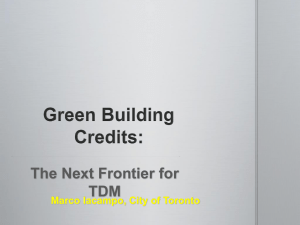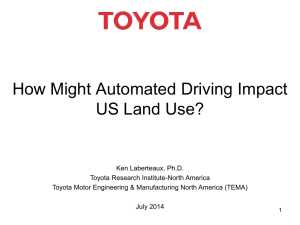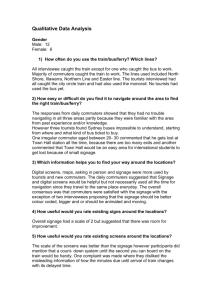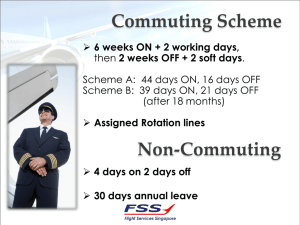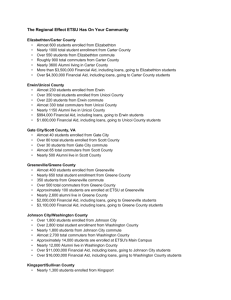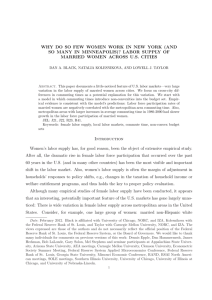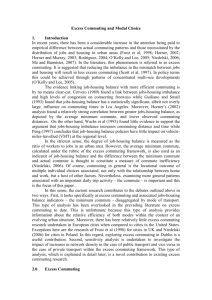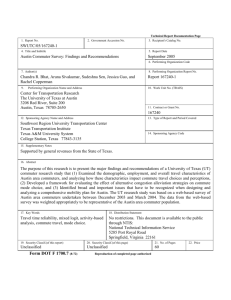Extreme Commuting Illustrates Tradeoffs and Opportunity Cost
advertisement
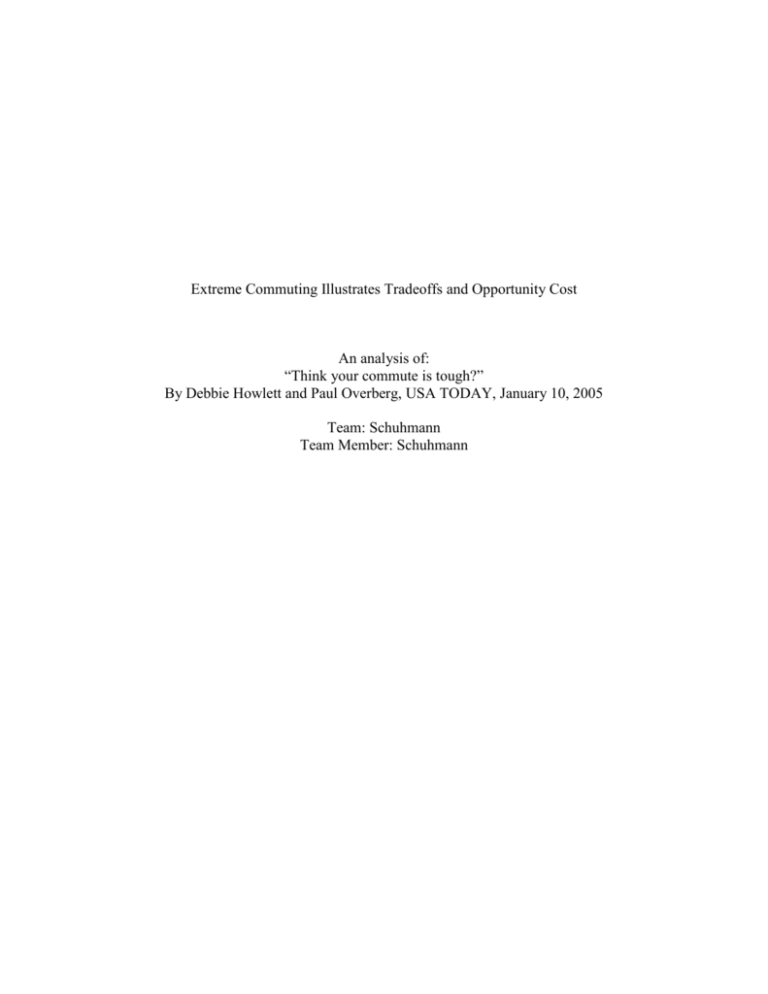
Extreme Commuting Illustrates Tradeoffs and Opportunity Cost An analysis of: “Think your commute is tough?” By Debbie Howlett and Paul Overberg, USA TODAY, January 10, 2005 Team: Schuhmann Team Member: Schuhmann Think your commute is tough? By Debbie Howlett and Paul Overberg, USA TODAY MOUNT POCONO, Pa. — The hard-and-fast rule on Martz Trailways Bus No. 101: no talking. Almost as soon as the bus lurches from the station at 5:05 a.m., the 42 bleary-eyed commuters slouch into their seats and squeeze as many z's as they can on the two-hour ride into New York City. The only sounds are soft snores. "The sun isn't even up," says Sandra Foster, 42, who's been making the 85-mile trip into Manhattan for nearly a year to her job as an information-technology recruiter. "The last thing anyone wants to do is chat." Foster is one of 3.4 million Americans who endure a daily "extreme commute" of 90 minutes or more each way to work. They're among the fastest-growing segment of commuters, according to a Census study, Journey to Work, released in March. Their commute times are more than triple the national average of 25.5 minutes each way. For many extreme commuters, the distance is so far they actually travel through several weather zones — from the edge of the Mojave Desert to the Pacific Ocean in Southern California, or from Pennsylvania resort towns in the Poconos to midtown Manhattan. Extreme commuting is being driven by strong forces. And this year's surge in gasoline prices hasn't deterred people from driving longer distances to get to work. Workplace shifts make it easier to telecommute, use flextime or work part time. Accelerating prices for close-in housing push people farther from cities to find affordable homes. And government planners, desperate to keep traffic moving, are spending billions to improve mass transit, including far-flung routes for express buses and commuter rail lines. Whatever the outlook, extreme commuters are pounding out the corridors of what will become the next generation of suburbs. That keeps planners paying close attention, because extreme commuters and housing developers who lure them to the fringes of sprawling metropolitan areas can quickly swamp local roads and government budgets. < Census Bureau Table deleted > People make these lengthy commutes for many reasons. A few want a rural lifestyle. Some are accommodating a spouse who works closer to home. Some even enjoy the trip. But most do it for a chance to buy into the American dream, says Alan Pisarski, a transportation consultant and author of Commuting in America. "We now have 60 million people living in non-metro areas. And we have people willing to commute ultra-long distances," he says. "It signals a substantial change coming in the way we commute." 'Driving 'til you qualify' Pisarski suggests that building more roads or mass transit options, such as trains or buses, would only encourage more long-distance commutes. The real change, he says, will be when companies build away from the metropolitan centers. He cites America Online, which built its corporate offices in Dulles, Va., 25 miles west of Washington, D.C., to attract nearby workers who previously commuted into the city. But AOL is the exception, not the rule. "You keep thinking that there's got to be some kind of tapering off (in commuting distances)," he says. "But it's hard to see any sign of an end." To afford a house in a neighborhood with good schools, low crime and Saturday morning youth soccer, extreme commuters keep high-paying jobs in the big cities and buy houses well beyond the traditional metropolitan area. In California's Antelope Valley, across a mountain range from Los Angeles, commuters call it "driving until you qualify." John Brooks, an economic analyst for Palmdale, a commuter boomtown 65 miles from the heart of Los Angeles with a population of 116,670, says residents literally get on the freeway and drive away from Los Angeles until they find a house with a mortgage payment that they can afford. Every mile away from the city drops the price of a house thousands of dollars. For example, the median cost of a house in Los Angeles in September was $405,000, according to the California Association of Realtors. In Palmdale it was $275,000. That difference has turned commuting distances that seemed unimaginable 20 years ago into daily routines. In the Antelope Valley, best known as home to Edwards Air Force Base, commuters talk about "driving down the hill." It's a clever understatement to describe the daily commute made by more than 20,000 area residents that begins at the edge of the Mojave Desert, wends over the San Gabriel Mountains and ends near the Pacific Ocean. On some winter days, drivers brave snowy mountain passes to jobs in the balmy city. But extreme commutes are not just about the driving distance. They are forcing federal, state and local officials to address continuing congestion and sprawl in ever-wider areas. Surveys long ago established that 45 minutes is the threshold most commuters were willing to drive one way to work. But the number of Americans making commutes longer than that has grown steadily to more than 19 million, according to the Census. That's one in six commuters, up from one in eight in 1990. In the Antelope Valley, planners are moving toward mass transit rather than building more freeways to alleviate congestion. Palmdale has lobbied hard to get a station on California's planned $35 billion high-speed train line, which will run from San Francisco to San Diego at speeds of up to 200 mph. The route, going through Palmdale, is expected to be approved at state planning meetings next month. Voters throughout California would still need to approve a $20 billion bond measure to finance the rail line. According to Brooks, the economic analyst, it likely would take 10 years to build. But, the train would cut in half the 90-minute commute by car to the city. And Brooks says the effect for commuters would be equivalent to building an eight-lane freeway. Not all extreme commuters are driving from the distant edges to the middle of big cities. A few are driving from one rural location to another, such as commuters in places like Rifle, Colo.; Salyersville, Ky., and Indian Wells, Ariz. Most of those commutes of 90plus minutes cover 100 miles or more on open road, rather than shorter trips on congested freeways. 'What you can get used to' David Argenti, for example, works for NASA at the Marshall Space Flight Center in Huntsville, Ala. He lives in Spring Hill, Tenn. For seven years he's been making the 200mile round trip every day. He started it because his wife had a job with the carmaker Saturn in Spring Hill. "It's amazing what you can get used to," Argenti says. He's on his second commuting car, a Saturn, which he bought 10 months ago. It already has 55,000 miles. He gave up the previous Saturn after 255,000 miles. Argenti, 42, was fine with the commute until his daughter was born four years ago. Now he wants those three hours a day back. His wife is now studying for a real estate license, so the family is considering moving back to Huntsville. New ways of working — telecommuting, a compacted workweek, low-cost airlines — are allowing people to pull back from traditional commuting patterns. David Meyer is a sociology professor at Brown University in Providence and lives in St. Louis, where his wife is president of a private school. Meyer commutes to Brown by Southwest Airlines every week during the academic year. He's been making the trip for five years, since they moved to Missouri from Connecticut. He's been on the Brown faculty since 1981. Meyer, 61, has it down to a science, spending two or three nights midweek at Brown, where he puts in 30-40 hours at his office. He stays at a bed and breakfast a few blocks from his office. He travels with only bare essentials and flies the same routes. The key is his short workweek, he says, and high-speed Internet connections that allow him to do research from home. "It's just my regular routine," Meyer says. "It's far less stressful than when I was commuting by car 50 miles from Connecticut." Kirk Robinson's commute is also unusual. He bicycles from his house on Bainbridge Island to the ferry across Puget Sound to downtown Seattle. Then he bikes up the hill to his office at the Environmental Protection Agency. It's nearly 90 minutes door-to-door. It's faster than driving, but that's not why Robinson, 50, does it. Even after seven years, he's captivated by the boat ride across one of the most beautiful harbors in the world. "Forty minutes of the trip is spent sitting on the ferry, which I wouldn't trade for any bus, car or train," he says. Some find the benefits For most commuters, economic necessity pushes them to the extremes of commuting. But some, like Foster, find there are other benefits. Married just more than a year, she rides the Martz bus four days a week. On Fridays she telecommutes. She's up at 4 a.m., on the bus at 5 a.m. and in Manhattan by 7 a.m. Most nights, she's home by 6:30 p.m. She's been doing it since she and her husband gave up an apartment in Queens for a house on 1½ acres in Mount Pocono, which is about the closest to New York City where they could afford a house. Her husband found work here, but she chose to keep her job in Manhattan. "People who don't do it don't understand it," Foster says. "No matter where you live in (New York), it's an hour commute. I'm just adding on 45 minutes or so. It's worth it to me" to own a home. Commuters like Foster have pushed the time frame on commuting to all-time highs. A typical New York City worker commutes 40 minutes each way. Steven Zaricki, a researcher for the Northeastern Pennsylvania Alliance, an economic development group representing seven Pennsylvania counties, says nearly 25,000 people a day from this region travel into New York City for work, more than half are from Monroe County, where Foster lives. Foster spends much of her commute reading or napping. Her payoff though is after dinner, sitting alone and in silence on her deck, beneath a dark sky and away from the glare of city lights. "The stars are just amazing," she says. "And I can get up in the morning and not see a neighbor in any direction. Article Summary This article describes a growing trend of people taking long commutes to work. It provides both anecdotal evidence and aggregate statistics of driving distances, times and locations for a small segment of society that drives more than 90 minutes to get to their place of work. The article also provides many possible reasons for people taking such long commutes, despite high gasoline prices. Among the reasons are structural changes in the workplace (such as increased ease of telecommuting and a shorter work week), higher house prices closer to major metropolitan areas, and an increased affinity for rural lifestyles. The article also examines the consequences of commuting for government planners, the real estate market, and mass transit. *** note: this summary could be a bit better and a bit longer *** Economic Analysis This article provides a great example of many economic topics and principles including opportunity costs, the scarcity principle and the cost benefit principle. Economics is the study of choices under scarcity. More specifically, how and why individuals and firms make choices, given the scarcity of resources, and what the consequences of those choices are. The commuters in this article face two scarce resources: time and money. Those that take long commutes to work are essentially giving up one resource (time) in exchange for another (money). They are willing to trade hours commuting for higher salaries earned by working farther from home and/or lower house prices farther from the city. Assuming these individual are rational, these decisions must have passed the cost benefit test. That is, the costs of driving extra hours each day were less than the benefits from home ownership, a larger home or a rural lifestyle. Indeed, the article details one individual who experienced a change in costs, and no longer wished to commute. In other words, prior to the change, the costs of commuting were less than the benefits, but after the change, costs exceeded benefits. The costs in this case are best described as opportunity costs. Opportunity costs are basically what you give up when you make a choice. More formally, opportunity costs are the value of the next best, but unchosen alternative for your resource. The individual in the article (David Argenti) found that the benefits of his long commute outweighed the costs until his daughter was born. Now, the opportunity cost of spending 3-4 hours each day on the road is too high. Now he is giving up time with his child. This new opportunity for his time proved to be more valuable than the previous one, and now the costs of commuting are simply too high. In detailing the costs and benefits of commuting, the article also raises interesting issues regarding the measurement of costs and benefits. One individual rode his bike to work and also took a ferry. For him, the pure enjoyment of these two modes of transportation provided additional benefits to the commute so that it was worth his time. Interestingly, while many costs and benefits noted in the article were purely monetary (for example the benefits of lower home prices further from work), some were nonmonetary (such as joy of the ferry ride, the enjoyment of a rural lifestyle and time with family). It must be the case that these individuals are somehow converting these nonmonetary benefits to dollar values in order to complete their own cost-benefit analysis of the commute decision. Essentially, they are asking themselves how much that activity is worth to them. ** Note: based on coverage of chapters 1 & 2 only. Missing “reservation price” and potentially a discussion of comparative advantage. ** I’d probably give this a B if I were grading it. Chapter 3 extensions: supply and demand and the price of gas (and relation to commute as a complement good or perhaps a discussion of alternative means of commuting and how price of gas might affect choice of train, bus, car), or S&D and the price of houses.
